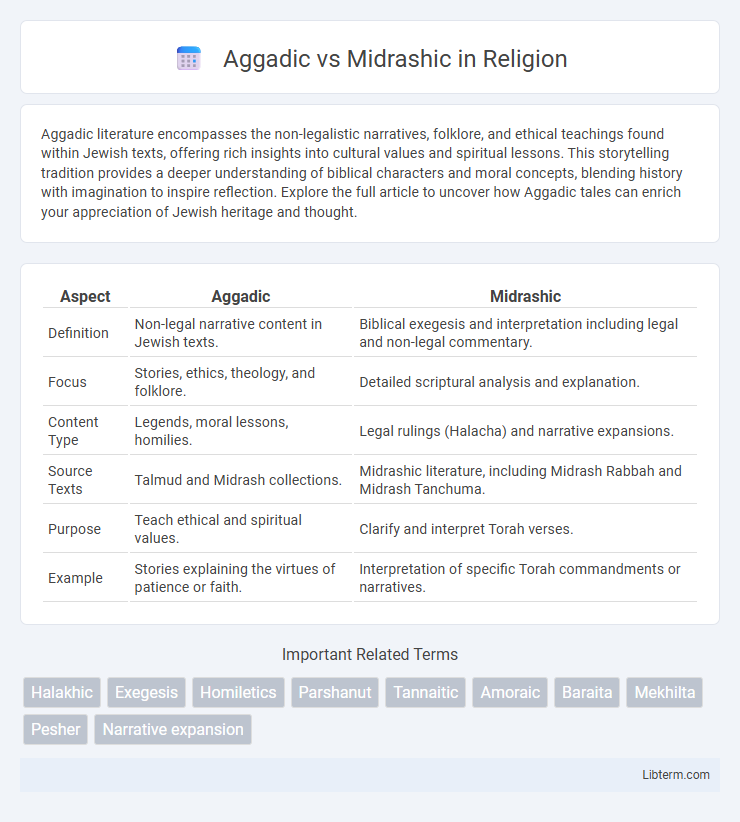Aggadic literature encompasses the non-legalistic narratives, folklore, and ethical teachings found within Jewish texts, offering rich insights into cultural values and spiritual lessons. This storytelling tradition provides a deeper understanding of biblical characters and moral concepts, blending history with imagination to inspire reflection. Explore the full article to uncover how Aggadic tales can enrich your appreciation of Jewish heritage and thought.
Table of Comparison
| Aspect | Aggadic | Midrashic |
|---|---|---|
| Definition | Non-legal narrative content in Jewish texts. | Biblical exegesis and interpretation including legal and non-legal commentary. |
| Focus | Stories, ethics, theology, and folklore. | Detailed scriptural analysis and explanation. |
| Content Type | Legends, moral lessons, homilies. | Legal rulings (Halacha) and narrative expansions. |
| Source Texts | Talmud and Midrash collections. | Midrashic literature, including Midrash Rabbah and Midrash Tanchuma. |
| Purpose | Teach ethical and spiritual values. | Clarify and interpret Torah verses. |
| Example | Stories explaining the virtues of patience or faith. | Interpretation of specific Torah commandments or narratives. |
Introduction to Aggadic and Midrashic Literature
Aggadic literature encompasses non-legalistic narratives, ethical teachings, and homilies found within the Midrash, emphasizing storytelling and moral lessons rooted in biblical texts. Midrashic literature broadly includes both aggadic and halakhic interpretations, providing expansive commentary that bridges scriptural gaps and elucidates complex passages. Together, Aggadic and Midrashic texts serve as foundational components of rabbinic tradition, enriching Jewish theological and ethical discourse through diverse exegetical methods.
Defining Aggadah: Meaning and Scope
Aggadah refers to the non-legalistic exegesis found in rabbinic literature, encompassing narratives, ethics, theology, and folklore that expand biblical texts' spiritual and moral dimensions. It serves as a broad category within Midrashic literature, emphasizing storytelling and homiletic interpretation rather than halakhic (legal) analysis. By exploring human experience and divine attributes, Aggadah enriches the understanding of scriptural themes beyond literal interpretation.
Understanding Midrash: Origins and Types
Midrash, originating from the Hebrew root "darash" meaning "to seek" or "to interpret," refers to a method of Jewish biblical exegesis that seeks to uncover deeper meanings in the Scriptures. There are two primary types of Midrash: Halakhic, which focuses on legal interpretations, and Aggadic, which encompasses narrative, ethical, and theological expansions on biblical texts. Aggadic Midrash, unlike the legalistic Halakhic, provides rich storytelling, moral lessons, and philosophical insights that enhance the understanding of biblical characters and themes.
Historical Context of Aggadic and Midrashic Texts
Aggadic texts emerged primarily in the early rabbinic period, serving as narrative and ethical expansions within the Talmud to convey moral lessons and spiritual insights. Midrashic literature developed alongside biblical exegesis, originating from the Second Temple period and evolving through the early medieval era, focusing on detailed scriptural interpretation and legal elucidation. Both Aggadic and Midrashic texts reflect the historical shifts in Jewish thought and religious practice during the transition from biblical to rabbinic Judaism.
Key Differences Between Aggadah and Midrash
Aggadah encompasses a broad spectrum of narrative, ethical, and theological teachings within Jewish tradition, often conveyed through stories, parables, and moral lessons. Midrash specifically refers to exegetical interpretations of the Hebrew Bible, aimed at explaining or expanding scriptural texts through legal, mystical, or homiletic insights. Key differences include Aggadah's focus on non-legal, imaginative storytelling versus Midrash's role in scriptural analysis and commentary, with Aggadah serving more as folklore and Midrash functioning as a method of biblical exegesis.
Literary Styles and Techniques
Aggadic literature employs narrative storytelling, parables, and homiletic discourse to convey ethical and theological themes, often using vivid imagery and allegory to engage readers. Midrashic texts utilize exegetical techniques such as close textual analysis, wordplay, and legal interpretation to expand and elucidate biblical verses, blending literal and creative readings. Both styles prioritize interpretive depth, but Aggadah emphasizes moral lessons through imaginative narratives while Midrash focuses on scriptural exegesis within rabbinic tradition.
Theological Themes in Aggadic and Midrashic Works
Aggadic works emphasize theological themes such as divine justice, mercy, and the moral lessons embedded in biblical narratives, often using storytelling to convey spiritual truths and ethical teachings. Midrashic texts incorporate a broader spectrum of theological exploration, including legal interpretations (Halakhah) and exegetical analysis that deepen the understanding of God's covenant, commandments, and the nature of divine-human interaction. Both Aggadic and Midrashic literature enrich Jewish theology by blending narrative imagination with interpretative rigor to illuminate sacred scripture.
Influential Aggadic and Midrashic Texts
Influential Aggadic texts like the Talmud and Zohar offer rich narrative interpretations and spiritual insights that shape Jewish thought and ethics. Midrashic texts such as Midrash Rabbah and Sifra provide exegetical expansions on the Torah, illuminating biblical laws and stories through allegory and homiletics. Both Aggadic and Midrashic literature play crucial roles in Jewish scholarship by blending law, mythology, and ethical teachings.
Role in Jewish Tradition and Interpretation
Aggadic literature enriches Jewish tradition by conveying ethical teachings, spiritual insights, and narrative expansions beyond legal texts, serving as a vehicle for moral and theological reflection. Midrashic texts function as exegetical tools that interpret, explain, and sometimes reconcile the Hebrew Bible's verses, offering diverse perspectives on scripture. Both Aggadic and Midrashic traditions play integral roles in interpreting Torah, merging law with storytelling to deepen understanding and religious experience.
Contemporary Relevance and Scholarly Perspectives
Aggadic literature offers rich narrative and ethical teachings that continue to influence contemporary Jewish thought, fostering moral reflection and spiritual growth. Midrashic approaches serve as vital tools for modern scholars, providing interpretative frameworks that connect ancient texts with current theological and cultural questions. Academic perspectives emphasize the dynamic interplay between Aggadah's imaginative storytelling and Midrash's exegetical methods, highlighting their ongoing relevance in both religious education and literary studies.
Aggadic Infographic

 libterm.com
libterm.com